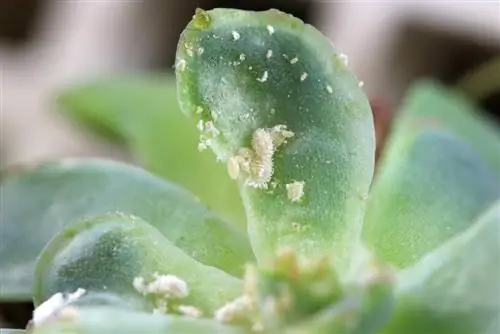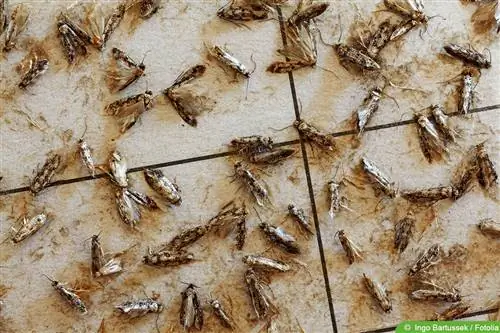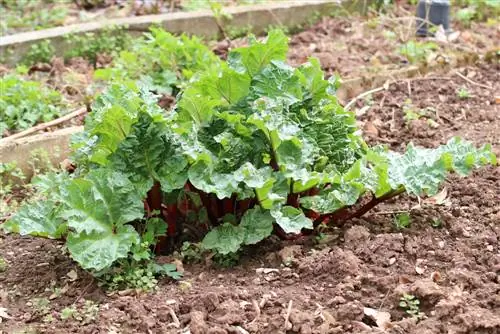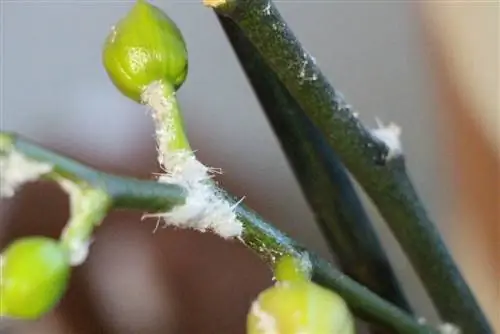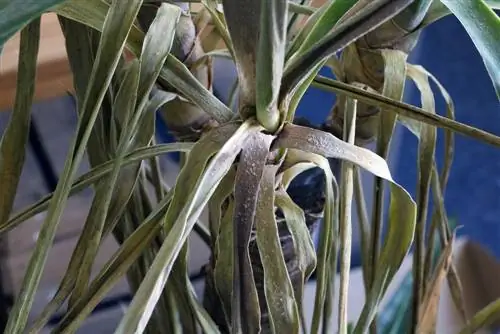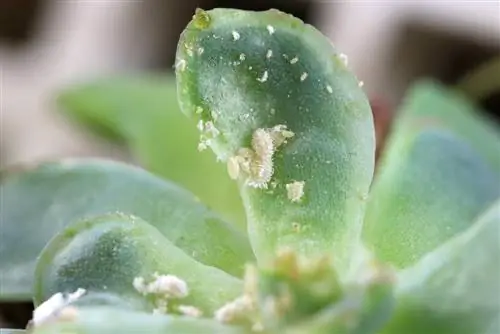- Author admin [email protected].
- Public 2023-12-17 03:39.
- Last modified 2025-06-01 06:48.
Mealybugs are usually easy to recognize because they attach themselves to the leaves of the plant and can also be seen with the naked eye. But there are also mealybugs that attach themselves to the roots of plants underground; these are known as root lice and are much harder to detect. To ensure that the plants do not suffer damage, they must be monitored regularly.
Root lice - definition
Mealybugs, aphids or scale insects, which also belong to the same family as root lice, are quickly recognized because they settle on the leaves and stems of plants. But root lice are plant lice that live underground and are therefore not seen so quickly. The root lice surround themselves with white or cream-colored wax secretions and suck on the roots of the infected plant. Root lice live in large colonies and therefore there is always a heavy infestation. Root lice look like this:
- small, two to three millimeter large animals
- present in quantities at the root of the plant
- Excretions from roots, root collars and soil
- white, waxy powder
Another sign of an infestation is lots of red ants near the plants. Root lice also form small piles of soil next to the plants.
malicious image
Plants that are already weakened are particularly susceptible to subterranean mealybugs. These include plants that show deficiency symptoms, that have already rotted due to waterlogging or that the soil around the roots is heavily compacted. The damage on infected plants looks like this:
- stun in growth
- wither even though they are sufficiently moist
- die off
- This is how large defects can arise in plant cultures
- an infestation of root lice is accompanied by an infestation of ants
- this is due to the honeydew excreted by the lice
The harvest of crops is reduced or even non-existent. Lettuce plants, for example, wilt from below and turn yellow. Infected berry plants have a lower yield, but the plant itself is hardly affected. Young bushes stop growing. Ornamental and house plants can suffer significant damage and die altogether.
Tip:
To be sure that the plants are infested with root lice, they must be carefully dug up. Otherwise, the small pests cannot be recognized because they are usually not on the surface of the earth.
Occurrences
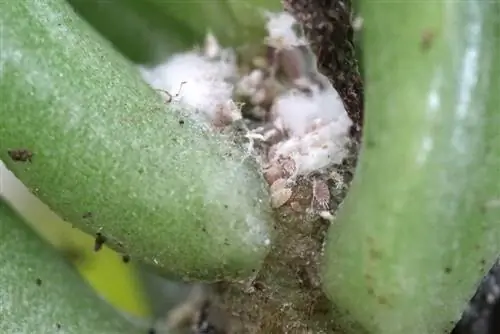
Almost all ornamental plants and vegetable plants can be attacked by root lice. But the pests particularly have a preference for spurge and thick-leaf plants. But flower bulbs are not spared either and tulips or daffodils can also be affected, like many other bulbous plants. Since there are different types of root louse that can even be host-specific, such as the salad root louse, to name one example, no plant is safe from infestation. The root louse is particularly common in the following vegetable crops:
- Endive, lettuce or chicory
- Carrots, celery or parsley
- Gooseberries and currants
- Houseplants
- Dieffenbachia, rubber tree, palm trees, cacti
- Balcony plants like geraniums or carnations
Many root louse species overwinter in plant residues on the ground, so it is important that all residues are completely removed after harvest. In this way, a new infestation next year can be contained or avoided.
Tip:
However, since root lice are considered to change hosts and prefer to lay their eggs on hawthorn or black poplar before moving to the vegetable patch, a mixed culture of these plants in the vegetable garden should be avoided.
Prevention
Better than fighting an infestation, it is to prevent it so that an infestation cannot occur in the first place. Because it is precisely when the soil conditions are unfavorable for plants of all kinds that root lice infestation occurs. The pests prefer compacted or dry soil, so it should always be kept loose and watered sufficiently. However, waterlogging should also be taken into account and avoided here, as pests also like to attack these weakened plants. Other preventive measures include the following:
- regular crop rotation in vegetable cultivation
- Create mixed culture
- Tomatoes, onions and leeks go well together
- keep pests away with their smells
- Choose resistant commercial varieties for lettuce
- Create drainage in the bed or pot to prevent waterlogging
- Lay insect protection nets (flea net) over crops in the garden
Fight
Once a plant or even an entire vegetable patch has been attacked by root lice, it becomes difficult to combat them. A distinction should also be made between perennial and annual plants when controlling them. Infected annual plants are often not worth the effort to save. The progress of the infestation is also important and how to proceed:
- Expose root area
- water regularly with tansy or nettle broth
- Dig up infected plants grown in containers
- Wash the roots and completely remove the lice
- then place in a water bath for several hours
- place in fresh soil
- Clean pots thoroughly beforehand
- use natural enemies in the garden bed
- Add commercial neem worms to the irrigation water
As soon as a bed with carrots or lettuce plants is severely affected, it makes more sense to destroy the plants completely and remove and clean the soil. The affected plants and their remains should under no circumstances be added to the compost but should be disposed of with household waste. Because the root lice can overwinter in the compost and will then be spread back into the garden with the fertilizer next year and could cause a lot of damage.
Tip:
The root louse's natural enemies include millipedes, ground beetles and short-winged beetles. Therefore, these animals should not be controlled in a kitchen garden. It is better to offer shelter made of stones or old pottery shards. This allows useful enemies to settle around the garden bed.
Make nettle or tansy broth
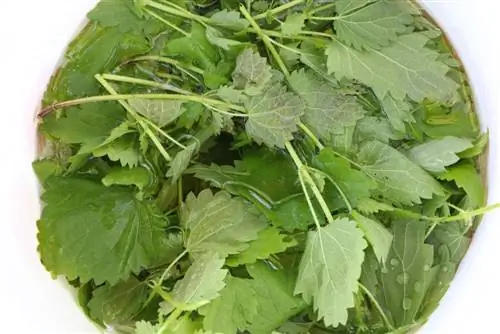
A bed can also be watered with tansy or nettle broth as a preventive measure. This does not harm the plants, but is helpful in preventing root lice infestations. The broth can be made yourself, but is also available as a ready-made product from well-stocked garden shops. When making your own, you proceed as follows:
- Collect tansy flowers and whole plants in August
- drying
- hang the upside down bouquet in a warm place
- Brew a tea from dried leaves
- let it cool down and add it to the water
- Collecting nettles
- prepare one kilogram fresh with two liters of water
- boil and let cool
- Sift plant parts
- add to irrigation water in a ratio of 1:10
The tansy, like the nettles, can also be processed fresh into a broth. This involves mixing around 1.5 kilograms of flowering tansy with ten liters of water, soaking it for 24 hours and then boiling it.
Tip:
Since the tansy flower contains most of the active ingredients, they are highly recommended for preparing the decoction. The tansy blooms in late summer, but since the plants are dried, they can be prepared in the fall for use in the spring/summer of the next year.
Cleaning infected soil
The affected soil can also be cleaned. But this is only possible if it is potted soil. Garden soil, on the other hand, can be removed and treated with systemic insecticides. However, if you want to be on the safe side, replace the soil with new soil. The old one can be placed in the residual waste in well-sealable garbage bags. Under no circumstances should it end up in the wild, as the root lice still in it could then spread into a forest or field. Cleaning potted soil is as follows:
- Place the affected soil in a microwave-safe container
- heat to 700 watts
- leave in the microwave for about four to five minutes
- the lice should be killed like this
Tip:
If you want to be on the safe side, you can also use commercial chemical agents to combat root lice from the garden or pot soil.

